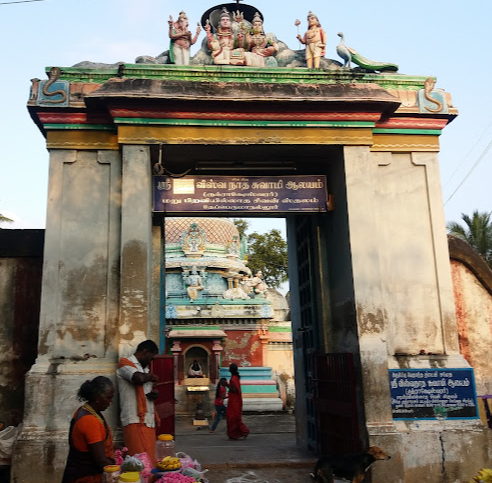The Rudrakeshwarar Temple in Thepperumanallur, near Thanjavur, has origins dating back several centuries, rooted in the rich cultural and religious history of Tamil Nadu. It is believed to have been built during the Chola dynasty, which was known for its patronage of art and architecture. The temple has undergone various renovations and expansions over time, reflecting the contributions of different rulers and devotees. Historical inscriptions found at the site provide insights into its ancient legacy and the significance of Lord Shiva worship in the region. The temple continues to be a vital centre for spiritual practices and cultural activities, preserving its historical essence while serving the contemporary community.

Rudrakeshwarar Temple
The Rudrakeshwarar Temple, also known as Viswanatha Swamy Temple, is a Hindu temple dedicated to Lord Shiva. Located in Thepperumanallur village, Thanjavur, it's believed to be built by the Chola king Raja Raja Chola I in the 10th century. The temple is known for its Dravidian architecture and its association with the legend of the 12 Jyotirlingas. The presiding deity is Lord Shiva enshrined as Rudraksheswarar or Viswanathar. The sanctum sanctorum houses the Shiva lingam, said to be self-manifested. Worshipping here is considered equivalent to worshipping all 12 Jyotirlinga temples in India.
Timings
Morning : 6:00 AM to 10:00 AM & Evening : 6:00 PM to 8:00 PM
Entry Fee
No entry fee is charged
Do's and Don'ts
- Respectful Attire: Wear modest and appropriate clothing such as traditional Indian attire (dhoti for men, saree or salwar kameez for women) when entering the temple premises.
- Follow Temple Rules: Adhere to the rules and regulations of the temple, including guidelines on photography, footwear removal, and behaviour inside the sanctum sanctorum.
- Offerings: If making offerings, ensure they are appropriate to the temple customs (flowers, fruits, incense, etc.) and presented with reverence.
- Silence and Respect: Maintain a respectful demeanour inside the temple, avoiding loud conversations or disruptive behaviour.
- Participate in Rituals: If comfortable, participate in temple rituals and prayers respectfully, following the instructions of priests or temple authorities.
- Donate and Support: Consider making donations or offerings for the upkeep and maintenance of the temple if inclined to do so.
- Footwear Inside: Remove footwear before entering the temple premises, as shoes are not permitted inside the sanctum sanctorum or main prayer areas.
- Disrespectful Behaviour: Avoid touching or climbing on temple structures, sculptures, or idols, as they are sacred and should be treated with reverence.
- Photography Restrictions: Respect any restrictions on photography inside the temple, particularly in sensitive areas or during rituals.
- Non-Devotional Activities: Refrain from engaging in non-devotional activities such as eating, drinking, or smoking inside the temple premises.
- Noise and Disturbance: Maintain silence or speak softly to avoid disturbing other devotees who are engaged in prayer or meditation.
- Disrespecting Customs: Do not disregard or mock temple customs, practices, or beliefs, even if they differ from your own.
Dress Code
For Men: Men often wear traditional attire such as a dhoti (a long cloth wrapped around the waist) or a veshti (similar to a dhoti but usually with a broader border). Men may wear a shirt or a traditional angavastram (a shawl draped over the shoulders) over the upper body.
For Women: Women commonly wear a saree, which consists of a drape usually worn over a petticoat, accompanied by a blouse. Alternatively, women may wear a salwar kameez (a long tunic paired with loose-fitting pants and a dupatta or scarf). Avoid Tight or Revealing Clothing: It is respectful to avoid tight-fitting or revealing clothing. The attire should cover the shoulders, midriff, and legs appropriately.
How to reach
By Air: The nearest airport to Thepperumanallur is Tiruchirappalli International Airport, also known as Trichy Airport. From the airport, you can hire a taxi or use local transportation to reach Thepperumanallur, which is approximately 60 kilometres away.
By Train: The nearest major railway station is Thanjavur Junction, which is well-connected to various cities and towns across India. From Thanjavur Junction, you can take a taxi, auto-rickshaw, or local bus to reach Thepperumanallur, which is around 20 kilometres away.
By Road : The nearest bus stand is Kumbakonam Railway Station, which is well-connected to various cities and towns across India.
Nearby Cities and Rivers
Rivers:
- Kaveri River: One of the major rivers of South India, the Kaveri flows relatively close to Thanjavur district, influencing its agricultural landscape.
- Vennar River: A tributary of the Kaveri, it flows through parts of Thanjavur district, contributing to the region's irrigation and water resources.
Cities and Towns:
- Thanjavur, a cultural and religious hub with renowned temples, art, and music.
- Tiruchirappalli (Trichy), noted for historic temples and the iconic rock fort, lies 60 kilometres northeast.
- Kumbakonam, near Thanjavur, famous for temples including the Mahamaham tank.
- Mayiladuthurai, east of Thanjavur, is celebrated for its temples and cultural significance.